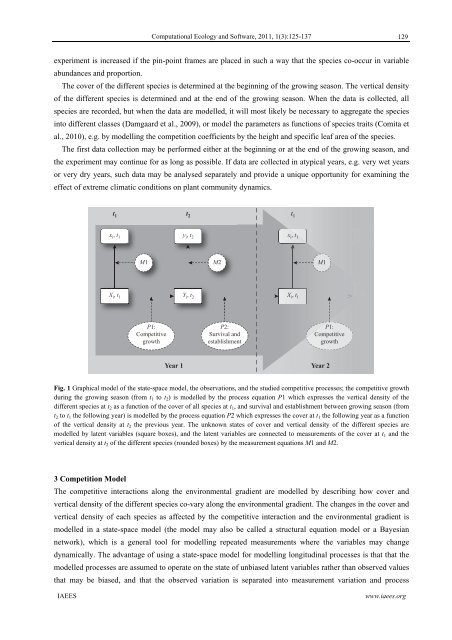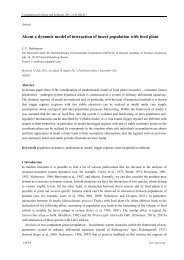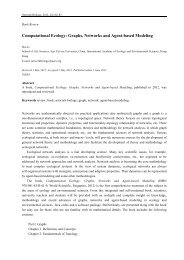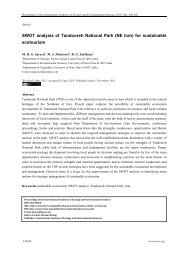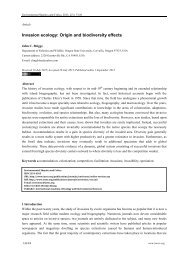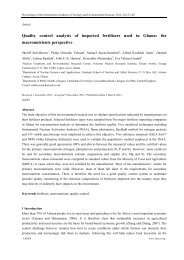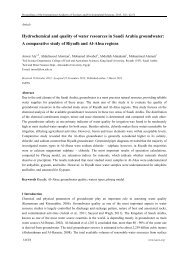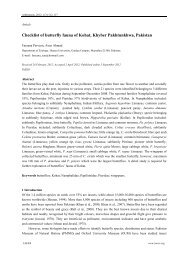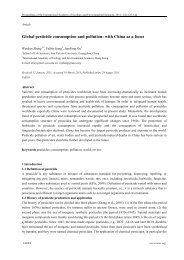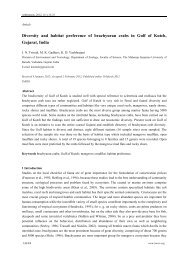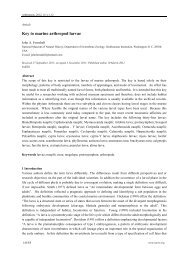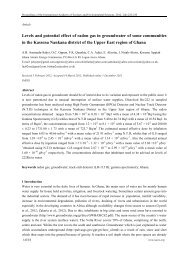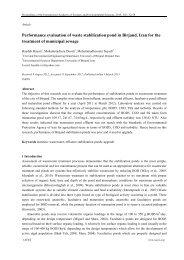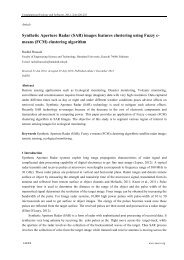Measuring competition in plant communities where it is difficult to ...
Measuring competition in plant communities where it is difficult to ...
Measuring competition in plant communities where it is difficult to ...
You also want an ePaper? Increase the reach of your titles
YUMPU automatically turns print PDFs into web optimized ePapers that Google loves.
Computational Ecology and Software, 2011, 1(3):125-137<br />
129<br />
experiment <strong>is</strong> <strong>in</strong>creased if the p<strong>in</strong>-po<strong>in</strong>t frames are placed <strong>in</strong> such a way that the species co-occur <strong>in</strong> variable<br />
abundances and proportion.<br />
The cover of the different species <strong>is</strong> determ<strong>in</strong>ed at the beg<strong>in</strong>n<strong>in</strong>g of the grow<strong>in</strong>g season. The vertical dens<strong>it</strong>y<br />
of the different species <strong>is</strong> determ<strong>in</strong>ed and at the end of the grow<strong>in</strong>g season. When the data <strong>is</strong> collected, all<br />
species are recorded, but when the data are modelled, <strong>it</strong> will most likely be necessary <strong>to</strong> aggregate the species<br />
<strong>in</strong><strong>to</strong> different classes (Damgaard et al., 2009), or model the parameters as functions of species tra<strong>it</strong>s (Com<strong>it</strong>a et<br />
al., 2010), e.g. by modell<strong>in</strong>g the <strong>compet<strong>it</strong>ion</strong> coefficients by the height and specific leaf area of the species.<br />
The first data collection may be performed e<strong>it</strong>her at the beg<strong>in</strong>n<strong>in</strong>g or at the end of the grow<strong>in</strong>g season, and<br />
the experiment may cont<strong>in</strong>ue for as long as possible. If data are collected <strong>in</strong> atypical years, e.g. very wet years<br />
or very dry years, such data may be analysed separately and provide a unique opportun<strong>it</strong>y for exam<strong>in</strong><strong>in</strong>g the<br />
effect of extreme climatic cond<strong>it</strong>ions on <strong>plant</strong> commun<strong>it</strong>y dynamics.<br />
t 1<br />
Year 1<br />
t 2<br />
X i , t 1<br />
t 1 t<br />
2<br />
x i , t 1 y i , t 2<br />
x i , t 1<br />
x i , t<br />
2<br />
M1<br />
M2<br />
M1<br />
X i , t 1 Y i , t 2<br />
X i<br />
, t<br />
2<br />
P1:<br />
Compet<strong>it</strong>ive<br />
growth<br />
P2:<br />
Survival and<br />
establ<strong>is</strong>hment<br />
P1:<br />
Compet<strong>it</strong>ive<br />
growth<br />
Year 2<br />
Fig. 1 Graphical model of the state-space model, the observations, and the studied compet<strong>it</strong>ive processes; the compet<strong>it</strong>ive growth<br />
dur<strong>in</strong>g the grow<strong>in</strong>g season (from t 1 <strong>to</strong> t 2 ) <strong>is</strong> modelled by the process equation P1 which expresses the vertical dens<strong>it</strong>y of the<br />
different species at t 2 as a function of the cover of all species at t 1 , and survival and establ<strong>is</strong>hment between grow<strong>in</strong>g season (from<br />
t 2 <strong>to</strong> t 1 the follow<strong>in</strong>g year) <strong>is</strong> modelled by the process equation P2 which expresses the cover at t 1 the follow<strong>in</strong>g year as a function<br />
of the vertical dens<strong>it</strong>y at t 2 the previous year. The unknown states of cover and vertical dens<strong>it</strong>y of the different species are<br />
modelled by latent variables (square boxes), and the latent variables are connected <strong>to</strong> measurements of the cover at t 1 and the<br />
vertical dens<strong>it</strong>y at t 2 of the different species (rounded boxes) by the measurement equations M1 and M2.<br />
3 Compet<strong>it</strong>ion Model<br />
The compet<strong>it</strong>ive <strong>in</strong>teractions along the environmental gradient are modelled by describ<strong>in</strong>g how cover and<br />
vertical dens<strong>it</strong>y of the different species co-vary along the environmental gradient. The changes <strong>in</strong> the cover and<br />
vertical dens<strong>it</strong>y of each species as affected by the compet<strong>it</strong>ive <strong>in</strong>teraction and the environmental gradient <strong>is</strong><br />
modelled <strong>in</strong> a state-space model (the model may also be called a structural equation model or a Bayesian<br />
network), which <strong>is</strong> a general <strong>to</strong>ol for modell<strong>in</strong>g repeated measurements <strong>where</strong> the variables may change<br />
dynamically. The advantage of us<strong>in</strong>g a state-space model for modell<strong>in</strong>g long<strong>it</strong>ud<strong>in</strong>al processes <strong>is</strong> that that the<br />
modelled processes are assumed <strong>to</strong> operate on the state of unbiased latent variables rather than observed values<br />
that may be biased, and that the observed variation <strong>is</strong> separated <strong>in</strong><strong>to</strong> measurement variation and process<br />
IAEES<br />
www.iaees.org


